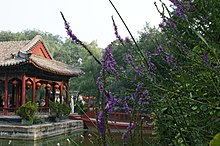
The Jiaqing Emperor,also known by his temple name Emperor Renzong of Qing,personal name Yongyan,was the sixth emperor of the Qing dynasty and the fifth Qing emperor to rule over China proper. He was the 15th son of the Qianlong Emperor. During his reign,he prosecuted Heshen,the corrupt favorite of his father and attempted to restore order within the empire while curbing the smuggling of opium into China. Assessments of his reign are mixed,either seen as the "beginning of the end" of the Qing dynasty,or as a period of moderate reform that presaged the intellectual movements of the 1860s.

The Qianlong Emperor,also known by his temple name Emperor Gaozong of Qing,personal name Hongli,was the sixth emperor of the Qing dynasty and the fourth Qing emperor to rule over China proper. He reigned officially from 1735 until his abdication in 1796,but retained ultimate power subsequently until his death in 1799,making him one of the longest-reigning monarchs in history as well as one of the longest-lived.

The Niohuru were a prominent Manchu clan during the Qing dynasty. The clan had inhabited the Changbai Mountains since as early as the Liao dynasty. The clan was well known during the Qing dynasty for producing a variety of consorts of all ranks for emperors,several of whom went on to become mothers to reigning emperors. Prominent people who belonged or trace heritage to the Niohuru clan including famed Manchu warrior Eidu,his son the high official Ebilun,the Empress Dowager Ci'an,the infamous corrupt official Heshen,the contemporary concert pianist Lang Lang and Lang Tsuyun,Taiwanese TV,movie and stage actress,singer and producer.

Kunqu,also known as Kunju (崑劇),K'un-ch'ü,Kun opera or Kunqu Opera,is one of the oldest extant forms of Chinese opera. It evolved from a music style local to Kunshan,part of the Wu cultural area,and later came to dominate Chinese theater from the 16th to the 18th centuries. It has been listed as one of the Masterpieces of the Oral and Intangible Heritage of Humanity by UNESCO. Wei Liangfu refined the musical style of kunqu,and it gained widespread popularity when Liang Chenyu used the style in his drama Huansha ji. In 2006,it was listed on the first national intangible cultural heritage list. In 2008,it was included in the List of Representative Works of Intangible Cultural Heritage of Humanity. In December 2018,the General Office of the Ministry of Education announced that Peking University is the base for inheriting excellent traditional Chinese culture in Kunqu.

The Yonghe Temple,also known as the Yonghe Lamasery,or popularly as the Lama Temple,is a temple and monastery of the Gelug school of Tibetan Buddhism located on 12 Yonghegong Street,Dongcheng District,Beijing,China. The building and artwork of the temple is a combination of Han Chinese and Tibetan styles. This building is one of the largest Tibetan Buddhist monasteries in China proper. The current abbot is Lama Hu Xuefeng. Yonghe Temple was the highest Buddhist temple in the country during the middle and late Qing dynasty.

Heshen (Manchu:ᡥᡝᡧᡝᠨ, Möllendorff:Hešen;Chinese:和珅;pinyin:Héshēn;Wade–Giles:Ho2-shen1;1 July 1750 –22 February 1799) of the Manchu Niohuru clan,was an official of the Qing dynasty favored by the Qianlong Emperor and called the most corrupt official in Chinese history. After the death of Qianlong,the Jiaqing Emperor confiscated Heshen's wealth and forced him to commit suicide. As an official,he acquired an estimated at 1.1 billion taels of silver,equal to roughly US$270 billion. Heshen is remembered as one of the richest men in history.

Chengde Mountain Resort is a large complex of imperial palaces and gardens situated in the Shuangqiao District of Chengde in northeastern Hebei province,northern China,about 225 kilometres (140 mi) northeast of China's capital Beijing. This resort was frequently used as a summer palace during the Qing dynasty. Because of its vast and rich collection of Chinese landscapes and architecture,Chengde Mountain Resort in many ways is a culmination of all the variety of gardens,pagodas,temples and palaces from various regions of China. In 1994,The Mountain Resort was awarded World Heritage Site status.

The Grand Council or Junji Chu,officially the Banli Junji Shiwu Chu,was an important policy-making body of China during the Qing dynasty. It was established in 1733 by the Yongzheng Emperor. The council was originally in charge of military affairs,but gradually attained a more important role and eventually attained the role of a privy council,eclipsing the Grand Secretariat in function and importance,which is why it has become known as the "Grand Council" in English.
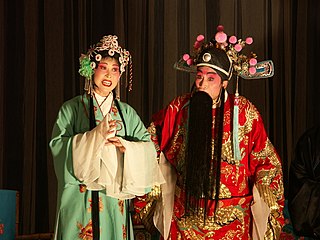
Sichuan opera is a type of Chinese opera originating in China's Sichuan province around 1700. Today's Sichuan opera is a relatively recent synthesis of five historic melodic styles. Regionally Chengdu remains to be the main home of Sichuan opera,while other influential locales include Chongqing,Guizhou,Yunnan,Hubei and Taiwan. Sichuan opera was listed in the first batch of 518 national intangible cultural heritage list announced on May 20,2006.
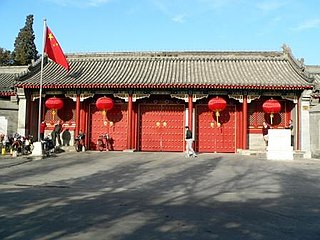
Prince Chun's Mansion,also known as the Northern Mansion,is a large residence in the siheyuan style with lavish private garden located near the Shichahai neighborhood in central Beijing. The grounds had been part of a villa built by Mingju,an official in the court of the Kangxi Emperor. It was later be seized by Heshen,a favorite of the Qianlong Emperor,and following Heshen's purge and execution in 1799,it was bestowed on Yongxing by his brother the Jiaqing Emperor,and the mansion was renovated. The mansion would change hands several times,eventually ending up as the residence of a minor Qing official named Yusu. In 1888,it was granted to Yixuan,the biological father of the Guangxu Emperor,by his sister-in-law,Empress Dowager Cixi. In 1891,the Yixuan died,and his title and mansion were inherited by his second surviving son,Zaifeng;Zaifeng's own eldest son,Puyi,the last Qing emperor,was born at this mansion in 1906.
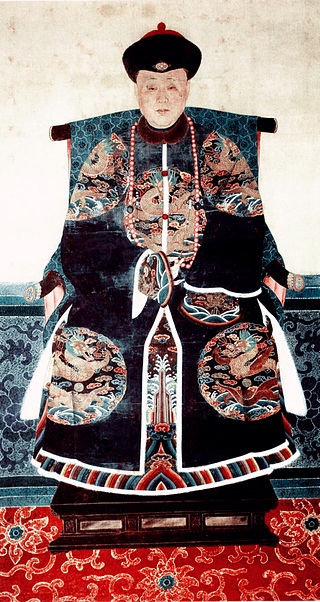
Princess Hexiao of the First Rank was a Manchu princess of the Qing dynasty. She was the tenth and youngest daughter of the Qianlong Emperor. Her mother was Consort Dun.

The former residence of Soong Ching Ling is a museum in the Shichahai area of Beijing,China,and once was the last residence of Soong Ching-ling,the wife of Sun Yat-sen and later Vice-President and Honorary President of the People's Republic of China in 1981. The museum opened in 1982,while it was listed as a National Key Cultural Relic Protection Unit. It was renovated in 2009,and is dedicated to her memory.
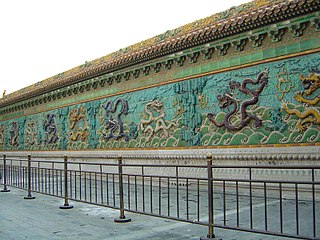
The Palace of Tranquil Longevity,literally,"peaceful old age palace", also called the Qianlong Garden,Qianlong Palace,Qianlong District or the Palace of Tranquility and Longevity,is a palace in Beijing,China,located in the northeast corner of the Inner Court of the Forbidden City.
The Deliberative Council of Princes and Ministers,also known as the Council of Princes and High Officials and Assembly of Princes and High Officials,or simply as the Deliberative Council,was an advisory body for the emperors of the early Qing dynasty (1644–1912). Derived from informal deliberative groups created by Nurhaci (1559–1626) in the 1610s and early 1620s,the Council was formally established by his son and successor Hong Taiji (1592–1643) in 1626 and expanded in 1637. Staffed mainly by Manchu dignitaries,this aristocratic institution served as the chief source of advice on military matters for Hong Taiji and the Shunzhi and Kangxi emperors. It was particularly powerful during the regencies of Dorgon (1643–1650) and Oboi (1661–1669),who used it to enhance their personal influence.
The history of the Qing dynasty began in the first half of the 17th century,when the Qing dynasty was established and became the last imperial dynasty of China,succeeding the Ming dynasty (1368–1644). The Manchu leader Hong Taiji renamed the Later Jin established by his father Nurhaci to "Great Qing" in 1636,sometimes referred to as the Predynastic Qing in historiography. By 1644 the Shunzhi Emperor and his prince regent seized control of the Ming capital Beijing,and the year 1644 is generally considered the start of the dynasty's rule. The Qing dynasty lasted until 1912,when Puyi abdicated the throne in response to the 1911 Revolution. As the final imperial dynasty in Chinese history,the Qing dynasty reached heights of power unlike any of the Chinese dynasties which preceded it,engaging in large-scale territorial expansion which ended with embarrassing defeat and humiliation to the foreign powers whom they believe to be inferior to them. The Qing dynasty's inability to successfully counter Western and Japanese imperialism ultimately led to its downfall,and the instability which emerged in China during the final years of the dynasty ultimately paved the way for the Warlord Era.
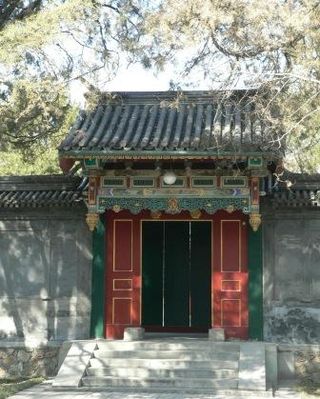
The Guo Moruo Residence (郭沫若故居) is the former residence of Guo Moruo (1892–1978) in West Qianhai Street,Dongcheng District,Beijing,China.

Qing poetry refers to the poetry of or typical of the Qing dynasty (1644–1911). Classical Chinese poetry continued to be the major poetic form of the Qing dynasty,during which the debates,trends and widespread literacy of the Ming period began to flourish once again after a transitional period during which the Qing dynasty had established its dominance. Also,popular versions of Classical Chinese poetry were transmitted through Qing dynasty anthologies,such as the collections of Tang poetry known as the Complete Tang Poems and the Three Hundred Tang Poems. The poetry of the Qing Dynasty has an ongoing and growing body of scholarly literature associated with its study. Both the poetry of the Ming dynasty and the poetry of the Qing dynasty are studied for poetry associated with Chinese opera,the developmental trends of Classical Chinese poetry and the transition to the more vernacular type of Modern Chinese poetry,as well as poetry by women in Chinese culture.
Yonglin,formally known as Prince Qing,was a Manchu prince of the Qing dynasty in China.
The Eloquent Ji Xiaolan is a Chinese historical comedy television series chronicling fictitious events in the life of Qing official Ji Xiaolan in the reign of the Qianlong Emperor. It stars Zhang Guoli as Ji Xiaolan,Wang Gang as Manchu official Heshen and Zhang Tielin as the Qianlong Emperor.
Hongjiao was Qing dynasty imperial prince as the fourth son of Yinxiang,Prince Yixian of the First Rank and Kangxi Emperor's grandson. In 1730,he was granted a title of Prince Ning of the Second Rank. As the title was not granted iron-cap status,each successive bearer would hold diminished ranks vis-a-vis his predecessor.
